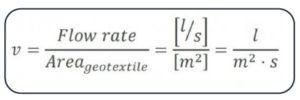The inclusion of an appropriately sized and weighted geotextile at the interface with the beach permits the free movement of water whilst retaining fine particles and preventing them from being washed away.
A geotextile filtration system must function throughout its deign life without clogging, this is vitally important since a coastal protection system cannot usually be easily re-installed.
Rather than stopping all particles from passing through the filter, a correctly sized textile will allow a percentage of smaller particles to pass through it. The overall coastal structure is then stabilised by the larger particles being held in place. Once in direct contact with the filter, the larger particles restrict the movement of the remaining particles to stabilise the entire soil layer.
The failure mechanisms that must be considered when specifying a filter for reverse flow applications include:
1) Soil retention – failure to retain soils in place may be due to an incorrectly specified pore size or inadequate contact between the soil and the filter. It could also be because of damage to the textile during installation or from abrasion in service.
2) Insufficient permeability – this can de-stabilise the entire coastal structure by creating excessive pore water build-up pressures. This could be due to the geotextile having a poor initial permeability at low head pressures, or excessive soil volumes being placed during installation causing localised blockages.

The primary properties critical to the performance of any geotextile filter specification are:
1) Pore Opening Size – the opening size of a geotextile is measured using EN 12956, determined from the particle size distribution of a graded granular material being washed through the geotextile filter.
The size of the largest particle collected in the sieve is theoretically the maximum opening size, however this value cannot always be practically measured. The standard therefore defines an O90 value whereby 90% of the average diameter of soil particles are retained in the sieve. For example, an O90 of 100 microns (i.e. 0.10mm) means that 90% of the pores are 0.10mm or smaller. In silty sand conditions particle sizes range from 2mm to 2 micron in size and any soil particles that are smaller than the geotextile pore size will pass through the geotextile, whilst the larger particles are retained.

To function correctly a coastal geotextile must have an opening size that is smaller than d50 – defined as the median particle diameter size. The established design rules for granular soils in reverse flow coastal conditions state that the geotextile’s O90 size should be less than the d50 of the soil being filtered and for a cohesive soil = O90 < 10 x d50.
2) Permeability – to ensure the free circulation of water and prevent an increase in internal pressure, basic filter principles govern that each layer of a filter system is more permeable than the layer beneath. The flow rate of water through the geotextile is therefore designed to be far greater than that of the flow rate through the soil so that the geotextile does not act as a barrier to the free drainage of water.
In coastal applications the permeability of sand is approximately 1 x 10-4 m/s and a typical nonwoven geotextile will have a perpendicular water flow of around 100 l/m2·s at a 50mm hydraulic head. This is at least 1,000 times greater than that of the granular soils.
In most applications the factor of safety for permeability is therefore very high, even allowing for some minor deterioration in the flow performance of the geotextile over time.
3) Extensibility – other properties which have a bearing on the geotextile’s filtration performance relate to its ability to conform to the contours of the underlying surface without spanning and the material’s elongation properties. Having a range of geotextile thicknesses available to suit the loading conditions is key to achieving this.
A correctly specified & installed coastal geotextile will:
• Restrict particle movement and maintain the overall soil structure
• Allow loose, fine particles to pass through it to prevent clogging
• Maintain permeability in the short and long-term
Find out more about our Coastal Protection Geotextile range here: Coastal Protection